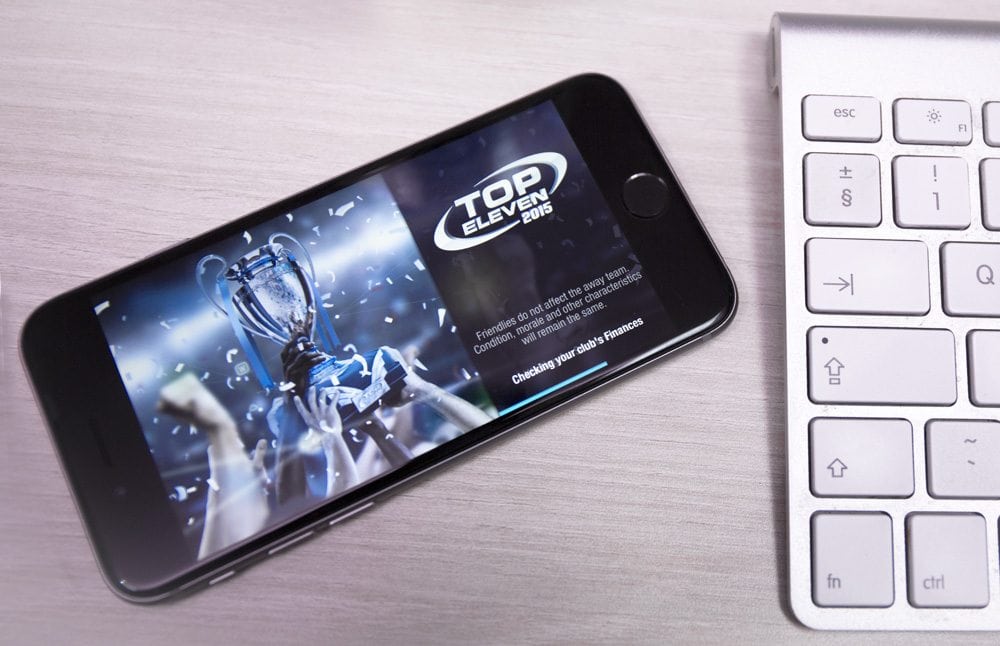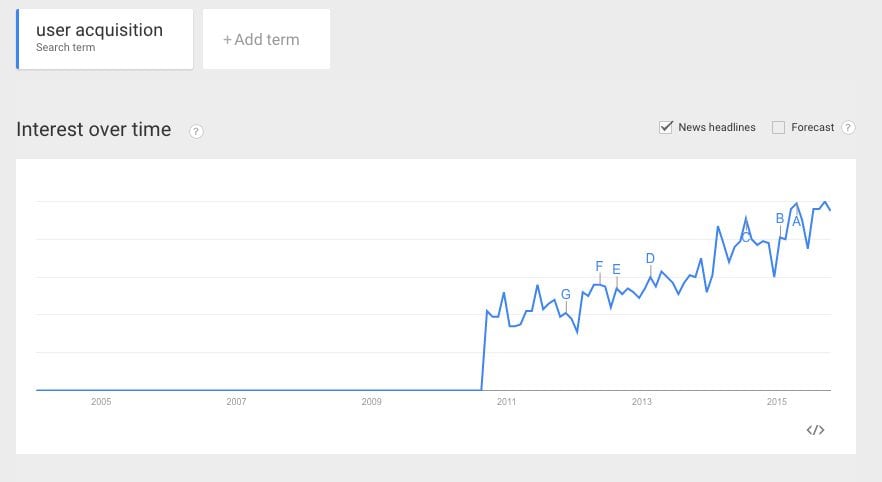
If you visit a big marketing conference such as dmexco in Cologne you’ll hear a lot about programmatic advertising/media buying, and how this is changing the advertising industry. Brands are investing more and more to online/mobile, shifting their budgets from brand to performance marketing. At the same time, you’ll see that digital brands such as Airbnb and Clash Of Clans are sponsoring events such as the 2015 EuroBasket championship and ESPN’s NBA broadcast. Traditional brands going to digital channels and digital brands going to traditional channels. Confusing? Let’s see how this looks like in the mobile gaming industry, where marketing is all about ‘user acquisition’ (UA) and compare the UA evolution with traditional marketing.
Term ‘User Acquisition’
“User acquisition” (UA), in the mobile gaming industry, usually stands for mobile marketing, paid advertising on mobile devices which brings new users into the game. According to Google trends, the term ‘user acquisition’ (UA) is in use since 2010, and has a similar meaning to older and much more common business term “customer acquisition” (CA). Similar, but not the same.
Basically if you are a User Acquisition Manager, you are in charge of media buying, mostly through mobile networks, calculating Cost Per Install (CPI) and measuring the quality (retention, LTV, …). In the ideal case, LTV > CPI (Lifetime value of user is greater than the cost of acquiring that user) which means your marketing efforts have a positive ROI. Usually, that’s everything that marketing did (still does in a great number of gaming companies).
Difference Between UA and CA
As it was already explained, user acquisition is similar to customer acquisition, but there are certain differences.
Customer Acquisition is described as “the process of bringing new customers to a particular brand, product or service”. The main difference from UA is that CA is the process, not just a technique. Primary goal of customer acquisition is to spend the least amount of money, to get as many customers as possible, by using all available marketing techniques. While UA is just one of techniques (paid mobile advertising) and if that is the most profitable way to acquire new users, then it’s almost the same thing.
But there are numerous reasons why paid mobile advertising isn’t a “cure-all” solution on mobile. Current trends are showing that average Cost Per Install keeps growing year over year, while the reach is still quite limited (especially for high quality users). However, the strongest reason is that the importance of brand is underestimated. Building a strong and recognizable brand supports different parts of the marketing funnel and is absolutely necessary if your brand wants to “go big”.
With this in mind, the question of “how to do customer acquisition?” is getting much more complex as there are many different ways to acquire these customers. And while paid mobile advertising is pretty much there when it comes to metrics and optimization, some other techniques are yet to be figured out and tracked properly. Even popular Website PocketGamer introduced new category: “Extreme UA” which is now renamed to “Next Wave UA”.
The Future of UA
‘Clash of Clans’ Super Bowl 2015 Commercial was chosen as one of the best Super Bowl Ads (Time) and was the most popular ad on YouTube (more popular than Budweiser’s Lost Dog or T-mobile’s Kim Kardashian ad). Clash Of Clans wasn’t the only game with an ad at Super Bowl. Game Of War and Heroes Charge ran spots during the big game also. In June, the London Underground was branded with Kate Upton (“Sports Illustrated” model) who starred in Game Of War’s Super Bowl ad and was the cover face of this free-to-play mobile game. ‘Come and Play With Me,’ said Kate Upton and her call to action seems to have been a really successful one.
ROI is the key metric when you are comparing performance ads. The key question now is: How to measure ROI if you are doing above the line (ATL) advertising? There are a few techniques which help you measure how TV advertising is influencing the number of organic installs or decrease in CPI’s if you are doing performance based advertising at the same time. But, if we are going to rely on old school channels, then we should also go back to Marketing Management (Kotler) and we must understand the concepts of brand equity and brand perception.
- How do you leverage brand equity to create and sustain competitive advantage?
- for example: market position (share, industry rankings…), brand perception, …
- How does brand perception influence audience/user behavior?
- for example: decrease of CPI’s in performance advertising, increase of word of mouth (Friends&Family are the no1 source of awareness for smartphone apps), increase of LTV…
It will not be easy to figure everything out at the beginning. But as soon as you start to think about your game as a brand, you’ll understand metrics much better. Then you will be able to make better decisions.



